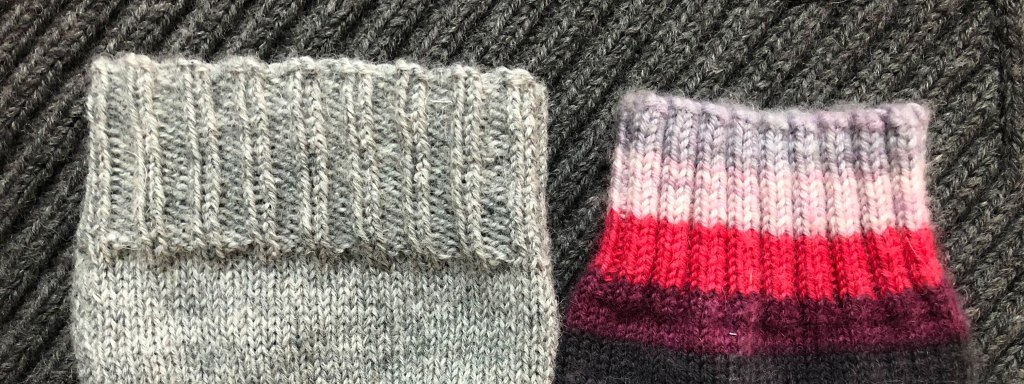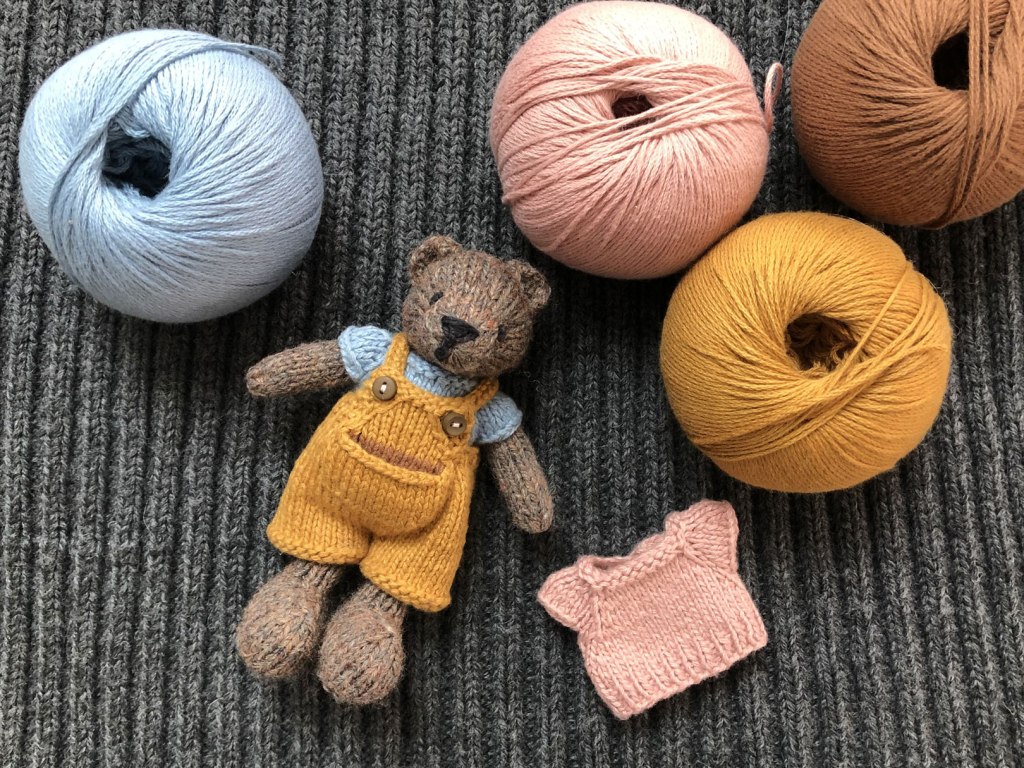Rewind / unwind / unpick / unravel / frog / begin again (Michael Finnegan). Just to give you a heads up, from the way things are going, these are the future titles of the next few blog posts. I’m just about to frog the sock again. Which is a shame actually, but also doesn’t matter.
After my last post I decided to start again, in grey. This time the cuff took forever because I did 2×2 twisted rib stitch, which is tighter than regular rib and so barely stretched across the needles. I like twisted rib stitch, but is it worth the hassle of trying to squeeze your way through every stitch? Maybe not for a sock. Weirdly, it stays stretched out once you’ve knit it, or it does for me. When I’ve done regular 2×2 rib it sort of sucks itself in and only stretches when you wear it. Twisted rib seems to stay stretched out. Wait – this photo will show you what I mean, twisted rib on the left, regular rib on the right.

Just me, or the same for everyone? Or actually, is it just this yearn? Anyway, once I got past the cuff I thought I’d make life easy and do some plain knitting. And then I thought maybe I should do some colour work after all. I know I said I don’t really like knitting colourwork, but everyone else’s socks on Instagram look really great – and… bleurgh. There you go.

This is an awful photo but I actually really like the sharpness of colour changes in knitting. I don’t think people make much use of it – often people try and soften the edges or try and create organic shapes in colourwork, but there’s something really nice about embracing the fact that slabs of colour just look good. So I went with colour blocks of 4 stitches. This is good because, 1) counting to 4 is easy to remember 2) carrying the other colour over 4 stitches is fine, you don’t need to do any weird ‘catching the float‘ techniques, which I know I’ll forget to do and then risk a flappy thread that’ll catch and break.

Somehow, I did pretty well with this. Usually, because I’m a tight knitter, the fabric gets really pinched when I knit in more than one colour. No matter how hard I try to keep the floats loose. But I think I did ok this time. Or maybe not.
I switched back to grey, measured it against the well fitting stripy sock and decided it was time to do the heel. I did an ok job with the heel itself, and for me, a decent job of picking up the stitches to get the whole sock back on the needle.

But here’s the thing. It just doesn’t fit well. I pulled it on to check the heel, and the colourwork section is just too tight. I can get it on alrightish, but it’s a slight squeeze every time. I would suggest if you’re (I’m) going to do this, and you don’t want to go up a needle size – which is what a lot of people do with colourwork, but I don’t want to do – then you’ll just have to add more stitches to account for the tightness of the floats. The yarn also shrinks ever so slightly in the wash too – even though it is listed machine washable at 30 degrees. If I did finish the sock it wouldn’t take long before I couldn’t wear it at all. So, I’ll unravel it and try again.
Who says knitting isn’t a cheap hobby? I’ve been using these same balls of yarn for entertainment for literally weeks. Maybe one day I’ll even get a functioning pair of socks out of them too.
I’m assuming someone’s written extensively about the fact you need to account for all this if you’re knitting colourwork socks, but never mind. Experience is a great teacher, as they say (when they’re being polite about the fact you’ve just screwed something up needlessly).
In more productive news, I knitted the bear a blue t-shirt. I think it’s better. Same as the rabbit in the previous post – which, it turns out, is loved.

So that’s where we’re at this week. A few steps forward in knowledge, and a lot of rows back in knitting.
The link to the catching the float method is SO helpful. I’ve never heard of this and for some reason never thought to find out how to deal with the long lines of wool I get behind colour work. The bear I just finished left me with red lengths of wool, at the back of his romper suit, that ran along nearly 30 stitches in some places! My solution was (and has always been) to cut these lengths in the middle (to relieve the tightness) then tie knots using the lengths running underneath each other (if you can remotely get what I mean) to finish them off securely – talk about unsightly and fiddly! Now things will look so much neater – it’s a knitting revelation!
Oh good! Yeah… I know you’re supposed to do it, but with complicated patterns I end up concentrating so hard on counting I’m always forgetting to catch the float. I also don’t knit with one colour in each hand – it looks like a great idea, but I can’t really knit continental style – can you? I think it must make life a lot easier.
I’d never heard of continental style until I found the Le Petit Saint Crochet channel, as never previously checked out knitting youtubers. I knit with the yarn hanging loose
and let go of the right hand needle to put the wool round it (bit difficult to explain in words.) My mum wraps the wool round her little finger, then intertwined in another finger and doesn’t let go of the needle (not that she knits much now.) I couldn’t fathom how she did it. My, probably completely wrong way, is what came naturally to me. My mum was amazed when I took up knitting in my twenties; never saw me as the knitting type. There probably isn’t a knitting type.